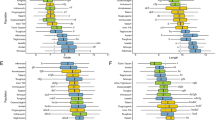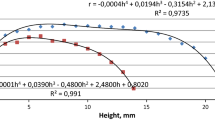Abstract
When analyzing sunflower (Helianthus annuus L.) remains, which are often carbonized, archaeobotanists commonly differentiate between wild and domesticated achenes and seeds based on the measured length (L) and width (W) or the calculated index L*W. Carbonization reduces the dimensions. To compensate for these reductions, archaeobotanists use a single correction factor proposed by Richard Yarnell (1978) for all cases. The use of a single correction factor can bias the reconstructed dimensions as carbonization is a highly variable process. The current study determines the relationship between carbonization and the dimensions of length and width. Measurements established that a decrease of 2.5-22.5% in achene length and 10-29% in achene width can occur, depending on temperature, heating rate, and variety. For seeds, temperature is of most importance, and shrinkage ranges from 0-27% for the length and from 0-20% for the width. These ranges make the use of a single correction factor problematic. A method is developed in which reflectance (an optical property applied in coal technology to determine coal rank) is used to measure the carbonization temperature, and in turn the shrinkage can be calculated. Subsequently, correction factors are calculated to reconstruct the original length and width. When applied to an assemblage of carbonized sunflower achenes, the newly developed method shows that the Yarnell single correction factor may bias the dimensions towards classifications of “wild” or “ruderal” forms of sunflower
Similar content being viewed by others
Literature Cited
Albini, F. A. 1993. Dynamics and modeling of vegetation fires: Observations. Pages 39–52 in P. J. Crutzen and J. G. Goldammer, eds. Fire in the environment: The ecological, atmospheric and climatic importance of vegetation fires. Wiley, Chichester, U.K.
Braadbaart, F., P. J. Wright, J. van der Horst, and J. J. Boon. 2007. A laboratory simulation of the carbonization of sunflower achenes and seeds. Journal of Analytical and Applied Pyrolysis 78:316–327.
—, J. van der Horst, J. J. Boon, and P. F. van Bergen. 2004a. Laboratory simulations of the transformation of emmer wheat as a result of heating: The change of the physical, bulk chemical and molecular composition. Journal of Thermal Analysis and Calorimetry 77:957–973.
— 2004b. Carbonization of peas and wheat—A window into the past. University of Leiden, Leiden, The Netherlands.
—, and P. F. van Bergen. 2005. Digital imaging analysis of size and shape of wheat and pea upon heating under anoxic conditions as a function of the temperature. Vegetation History and Archaeobotany 14:67–75.
-Braadbaart, F., and C. C. Bakels, n.d.. Carbonization and the morphological changes of modern dehusked and husked emmer and bread wheat grains (submitted).
Carr, A. D., and J. E. Williamson. 1989. The relationship between aromaticity, vitrinite reflectance and macerai composition: Implications for the use of vitrinite reflectance as a maturation parameter. Advances in Organic Geochemistry 16:313–323.
González Pérez, S. 2003. Physico-chemical and functional properties of sunflower proteins, University of Wageningen, Wageningen, The Netherlands.
Harl, Joseph L, and Patti J. Wright. 1994. Data recovery investigations at the Stelzer Site (23SC910), St. Charles County, Missouri. Paleothnobotanical Analysis, Research Report #191, Department of Anthropology, University of Missouri, St. Louis.
Heiser, C. B. 1953. The archaeological record of cultivated sunflower with remarks concerning the origin of Indian agriculture in eastern North America. Unpublished manuscript on file at the Archaeological Laboratory, University of Missouri, St. Louis.
Hillman, G. C., S. Mason, D. de Moulins, and M. Nesbitt. 1996. Identification of archaeological remains of wheat: The 1992 London workshop. Circaea 12:195–209.
Hopf, M. 1955. Formveränderungen von Getreidekörnern beim Verkohlen. Berichte der Deutschen Botanischen Gesellschaft 68:191–193.
International Standard ISO 7404-2. 1985. Methods for the pétrographie analysis of bituminous coal and anthracite. Part 2: Method of preparing coal samples. Ref. no. ISO 7404-2:1985(E).
International Standard ISO 7404-5. 1994. Methods for the petrographic analysis of bituminous coal and anthracite. Part 5: Method of determining microscopically the reflectance of “vitrinite.” Ref. no. ISO 7404-5:1994(E).
Jacomet, S. 1987. Prähistorische Getreide Fünde: Eine Anleitung zur Bestimmung Prähistorische Gerstenund Weizenfunde. Botanishes Institut der Universität Basel, Basel, Switzerland.
Kislev, M. E., and S. Rosenzweig. 1989. Influence of experimental charring on seed dimensions of pulses. Acta Interdisciplinaria Archaeologica 7:143–157.
Lentz, D. L, M. E. D. Pohl, K. O. Pope, and A. R. Wyatt. 2001. Prehistoric sunflower (Helianthus annum L.) domestication in Mexico. Economic Botany 55:370–376.
Nelson, Stuart O. 2002. Dimensional and density data and relationships for seeds of agricultural crops. Seed Technology 24:76–88.
Smith, H., and G. Jones. 1990. Experiments on the effects of charring of cultivated grape seeds. Journal of Archaeological Science 17:317–327.
van Zeist, W. 1970. Prehistoric and early historic food plants in the Netherlands. Palaeohistoria 14:41–173.
Veld, H. 2006. Personal communication,www.tno.nl.
Wilson, D. G. 1984. The carbonization of weed seeds and their representation in the macrofossil assemblages. Pages 199–206 in W. van Zeist and W. A. Casparie, eds. Plants and ancient man: Studies in palaeoethnobotany. A. A. Balkema, Rotterdam, The Netherlands.
Wright, P. J. 1998. The making of the carbonized macrobotanical record. Washington University, St. Louis, MO.
—. 2003. Preservation or destruction of plant remains by carbonization? Journal of Archaeological Science 30:577–583.
Yarnell, Richard A. 1978. Domestication of sunflower and sumpweed in eastern North America. Pages 289–299 in Richard I. Ford, ed. The nature and status of ethnobotany. Anthropological Papers No. 67, Museum of Anthropology, University of Michigan, Ann Arbor.
Author information
Authors and Affiliations
Corresponding authors
Rights and permissions
About this article
Cite this article
Braadbaart, F., Wright, P.J. Changes in mass and dimensions of sunflower (Helianthus annuus L.) Achenes and seeds due to carbonization. Econ Bot 61, 137–153 (2007). https://doi.org/10.1663/0013-0001(2007)61[137:CIMADO]2.0.CO;2
Received:
Accepted:
Issue Date:
DOI: https://doi.org/10.1663/0013-0001(2007)61[137:CIMADO]2.0.CO;2




